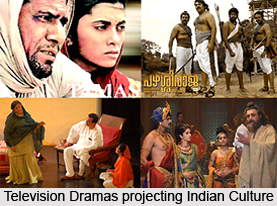 Television Drama, over the last two decades has gained huge popularity in the country. As a medium, television is a significant medium in India. It attracts the maximum attention as any emerging new media would. Having started as a medium purely for instruction and education, it has gradually had to make concessions to the growing demand for more entertainment.
Television Drama, over the last two decades has gained huge popularity in the country. As a medium, television is a significant medium in India. It attracts the maximum attention as any emerging new media would. Having started as a medium purely for instruction and education, it has gradually had to make concessions to the growing demand for more entertainment.
Over the years, as its viewing has increased, both in number and variety, the demands and expectations have become multidirectional. Television in India therefore is now faced with the challenge of sorting out these growing contradictions, asserting its significance and establishing a definite identity of its own.
The task, however, involves many complex problems. Firstly, the medium has to cater simultaneously to the tastes of people from varying cultural backgrounds, literacy levels and classes. Therefore in the planning of the programmes television, while keeping the interests of its wide clientele in mind, has to be careful not to lose sight of its own objectives that may often be at cross-purposes with popular demand.
 In setting up of the objectives, it might perhaps be useful to examine the dilemma that a medium of this nature is faced with. Television is a tremendously expensive medium and a country like India cannot afford to sustain it without the justification of it serving a definite social purpose i.e. removing illiteracy, increasing social awareness, inculcating familiarity with the varied regions and their cultures, etc.
In setting up of the objectives, it might perhaps be useful to examine the dilemma that a medium of this nature is faced with. Television is a tremendously expensive medium and a country like India cannot afford to sustain it without the justification of it serving a definite social purpose i.e. removing illiteracy, increasing social awareness, inculcating familiarity with the varied regions and their cultures, etc.
Television has to provide entertainment and yet fight against the demand for escapist entertainment. Television drama can therefore function at two levels one, of putting across social messages through carefully planned story lines and the other, the more significant one, to make people aware of subtle human relationships, problems and situations. It should be more directly related to real life, more sensitive and more human. It can take up any number of significant social and human issues and project them not necessarily in order to convey a moral or a message but just to increase some perception of human nature and problems. In other words, the drama has to lead to a more sensitive perception and acceptance of life, to the understanding of the environment in greater depth and to inculcation of finer values of life. This of course can only be a very slow process but one has to make a beginning and then it is a question of gradually attuning your audience to this process and to make them function on the same wave length.
For ages, Drama has been almost similar to Theatre, but with the emergence of media like the films and television the connotation of drama has changed and widened and now there are different manifestations of drama in all the three media. Each of these manifestations is conditioned by the essential and basic characteristics of the respective media.
Television drama, like films, has to have a more realistic, naturalistic portrayal of life and has the facility of shooting at different sets, locates and timings and is therefore not bound by unity of time and place. While in theatre the interpretation of a story is often communicated through positions, compositions and movement of characters, in films and television the interpretations differ through highlighting of certain visual imagery and symbols, juxtaposition of these images and shots, which can communicate the desired meaning without many words.
These, like the theatre, cannot use the straight narrative device of the story or the novel, but can convey the inner thoughts and emotions, the background and the development through a carefully worked out sequence of visual images. In fact, the visual imagery is conveyed in totality through the designing, the casting, the costumes, the shot compositions and the sequence of shots. The choice of shots, the order in which they are used, the emphasis on small objects or facial expressions are often able to convey much more and more effectively than what narration can do. Here, unlike theatre, the interpretation is totally in the hands of the director and he can make the audience see what he wants it to see in a particular story.




















